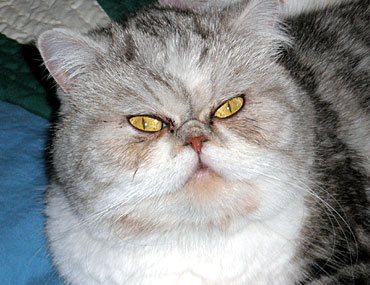Breed Basics
- Distinctive characteristics: soft, round “teddy-bear” appearance; quiet meow
- Coat: medium length; rich and soft—stands out from body due to thick undercoat
- Color: a variety, including solids (white, blue, black, red, cream, lilac, chocolate, silver, golden), tortoiseshell, and tabby
- Body: sturdy, with muscular legs
- Head: broad, rounded
- Eyes: large, round, and of a color that complements the cat’s dominant coat color (however, white exotics have blue eyes; black exotics have copper ones)
- Average weight: 7–14 pounds
- Temperament: easygoing, gentle, affectionate
What’s to Love?
Almost as popular as their Persian cousins, exotics have one very distinct difference, and it’s one of the main reasons people are attracted to them:
- Shorter, denser coats mean less grooming
- Quiet demeanor and vocalization
- Easily adapts to people as well as to other pets—preferably gentle ones
- Want to be with their people as much as possible
- Playfulness
- Intelligence
What to Watch For
- Should be indoor-only cats (because of docile temperament)
- Prefer peaceful environments to boisterous ones
- Congenital issues, such as asymmetrical jaw, leading to eating and/or dental issues
- Epiphora, or excessive tearing, and other eye issues (also congenital)
- Sinusitis, and other sinus issues (congenital)
The Exotic is a relatively new breed, having first been bred in the U.S. in the 1950s by crossing Persians with American shorthairs.
The breed’s popularity grew quickly, and it was recognized as a distinct breed just a decade after its first appearance.
If you have any questions or concerns, you should always visit or call your veterinarian – they are your best resource to ensure the health and well-being of your pets.
